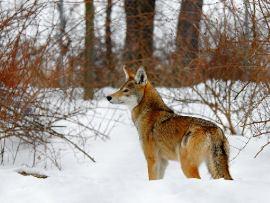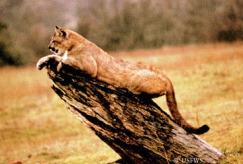by the Megafauna Reintroduction Front (MRF)

A red wolf awaiting reintroduction to the East Coast.
While we often talk about the illegality of eco-sabotage, we rarely talk about the potential for illegal restoration. Some of the laws involved, such as the Endangered Species Act, are, on the surface, there to protect these animals. We, as ordinary civilians, are told we lack the training and the jurisdiction to release such animals into the wild, but in the absence of official action we support the responsible transfer of predators back into their former homelands, without waiting for the approval of the US Fish and Wildlife Service.

eastern cougar
Most big cats across the planet, for example, are facing extinction within our lifetimes and local populations have already been extirpated. In the United States, the eastern cougar has recently been officially declared extinct, though they have been gone for decades. Jaguars may be extirpated north of the Mexican border.
Red wolves, once common across the Southeast, now live only in the swamps of eastern North Carolina, their population hovering around 120. Even with the success of gray wolf reintroduction, Turkey still has more wolves than the entire lower 48 of the United States. With such grim statistics, we cannot wait for underfunded government and non-governmental programs to turn things around. These are not just singular species; these are key components to functioning ecosystems, the embers of wildness still glowing in the night.
Critics will claim that such actions are irresponsible, both for the animals and humans involved. Is there anything more irresponsible than sitting around while species go extinct? There are wildlife biologists who know how to safely sedate large animals and we support them getting in touch with radical ecologists who know which lands are suitable for the release of a dozen cougars or a wolf pack. The animals will take care of themselves. Already, adaptable house cat-munching coyotes have spread across the eastern United States, filling some of the void left by wolves. Since the start of the Yellowstone wolf recovery program, wolves have spread into Idaho, Montana, and recently Oregon, with possible sightings in Colorado. Lynx reintroduction in the lower Rockies has been a great success. Elk have been successfully reintroduced in Pennsylvania, West Virginia and Kentucky. In some cases the plans for reintroduction already exist, but are sitting on a shelf. In some cases, animals can be obtained from captive breeding facilities. In other cases they may need to be obtained from wild populations. It is not because of lack of suitable habitat, but lack of political will that reintroductions have come to a standstill.
Habitats such as the White Mountains of New Hampshire, the Adirondacks and the North Woods of Maine are ideal for new wolf populations. The Appalachians and the coastal swamps of the Carolinas are ideal for cougar populations. We even support the covert reintroduction of grizzly bears into the Sierra Nevada. Wolf reintroductions in the Northeast have been derailed for years because of government ineptitude. The woods are waiting for the return of predators. They have missed the howls of the wolf.
We get excited when we read about the spread of large predators into their former habitats. We get even more excited when we think about how much quicker this dispersal would be with the help of humans. Other restoration projects that we would like to see happen include the removal of barb wire fencing around pronghorn habitat and the breaching of small dams to restore anadronous fish populations.
Everyone should be safe and smart and not ask too many questions about the sedated cougar in the back of your friend’s van, but we should never let unforgivable acts such as extinction happen merely because stopping it is dangerous or illegal. People who carry out such acts will not always succeed. There is a good chance that some of these animals will be shot by wildlife officials, but out of boldness comes eventual success. The animals will have a fighting chance.
Acts of sabotage inspired an entire generation of ecowarriors to stop waiting for governments and environmental lobbies to take action. Now, when the entire dialog around the environment has shifted from ecosystems to energy production, we need symbols of wildness that reminds us what is at stake. Nothing does that more effectively than a rash of mysterious cougar sightings in northern Georgia followed by a communiqué from a band of anonymous veterinarians, biologists and ecowarriors taking credit.
<a href="http://polldaddy.com/poll/6806020">Take Our Poll</a>
